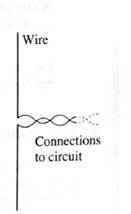
Imagine that the

1. Suppose that the wire were oriented parallel to the z-axis.
As the wave propagates past the wire, would the electric field due to the radio wave cause the charges in the wire to move? If so, would the charges move in a direction along the length of the wire? Explain.
As the wave propagates past the wire, would the magnetic field due to the cause the charges in the wire to move in a direction along the length of the wire? Explain.
2. Imagine that the thin conducting wire is cut in half and that each half is connected to a different terminal of a light bulb. (See diagram at right.)

If the wire were placed in the path of the radio wave and oriented parallel to the z-axis, would the bulb ever glow? Explain. (Him: Under what condition can a bulb glow even if it is not part of a closed circuit?)
How, if at all, would your answer change lithe wire were oriented:
• parallel to the y-axis? Explain.
• parallel to the x-axis? Explain.
3. Suppose that the bulb were disconnected and that each half of the wire were connected in a circuit, as shown. (A conducting wire or rod used in this way is an example of an antenna.)

In order to best detect the oncoming radio wave (that is. to maximize the current through the circuit), how should the antenna be oriented relative to the wave? Explain.
Learn your wayIncludes step-by-step video

Chapter 9 Solutions
Tutorials in Introductory Physics
Additional Science Textbook Solutions
College Physics: A Strategic Approach (3rd Edition)
Cosmic Perspective Fundamentals
Microbiology: An Introduction
Campbell Biology: Concepts & Connections (9th Edition)
Organic Chemistry (8th Edition)
Campbell Biology (11th Edition)

 Principles of Physics: A Calculus-Based TextPhysicsISBN:9781133104261Author:Raymond A. Serway, John W. JewettPublisher:Cengage Learning
Principles of Physics: A Calculus-Based TextPhysicsISBN:9781133104261Author:Raymond A. Serway, John W. JewettPublisher:Cengage Learning Physics for Scientists and Engineers: Foundations...PhysicsISBN:9781133939146Author:Katz, Debora M.Publisher:Cengage Learning
Physics for Scientists and Engineers: Foundations...PhysicsISBN:9781133939146Author:Katz, Debora M.Publisher:Cengage Learning Glencoe Physics: Principles and Problems, Student...PhysicsISBN:9780078807213Author:Paul W. ZitzewitzPublisher:Glencoe/McGraw-Hill
Glencoe Physics: Principles and Problems, Student...PhysicsISBN:9780078807213Author:Paul W. ZitzewitzPublisher:Glencoe/McGraw-Hill University Physics Volume 1PhysicsISBN:9781938168277Author:William Moebs, Samuel J. Ling, Jeff SannyPublisher:OpenStax - Rice University
University Physics Volume 1PhysicsISBN:9781938168277Author:William Moebs, Samuel J. Ling, Jeff SannyPublisher:OpenStax - Rice University University Physics Volume 3PhysicsISBN:9781938168185Author:William Moebs, Jeff SannyPublisher:OpenStax
University Physics Volume 3PhysicsISBN:9781938168185Author:William Moebs, Jeff SannyPublisher:OpenStax





